February 2004 (Part 3)
SELECTION OF QUESTIONS AND ANSWERS
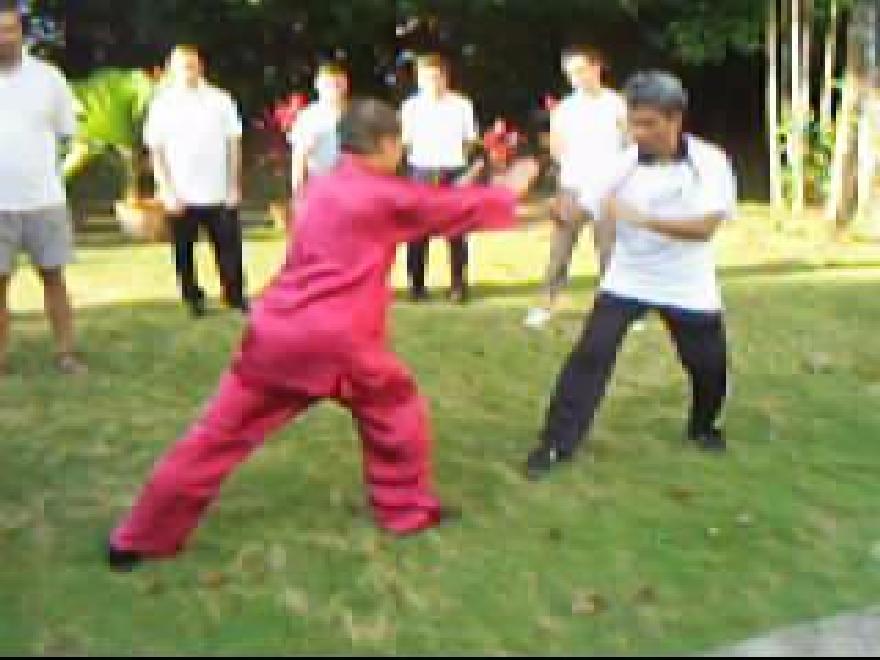
Grandmaster Wong and Sifu Joko demonstrating a combat sequence in Wahnam Taijiquan
Question 1
Three years ago I practiced “Lifting the Sky” regularly and even managed to gain some healthy weight (I was very underweight). I cannot recall my reasons, but I gave up the practice and turned to Western calisthenics — pushups, crunches, etc. Well, after three years of these Western exercises I am back to being forty pounds underweight and my abilities in these activities have actually suffered rather than improved! To make matters worse, I have suffered much anger and depression since then also.
I am intent upon restarting “Lifting the Sky” on a daily basis, but have a problem. The straighter my arms, the less I can bend my hands inward towards each other as the exercise requires. Only if I bend my elbows outwards quite considerably can I maintain the correct palm position. If I keep my arms straight then my fingers must slant downwards. As I understand that straining is bad in chi kung practice, I am unsure what to do for best results. Should I merely persevere with arms bent and try to improve hand-flexibility, or would this produce chi blockage due to the muscular tension?
— Alexis, Canada
Answer
Your problem is quite common among many of my students when they first learned chi kung from me. They could not bend their palms back comfortably because their arm muscles have become tight.
What you should do, as what my students had done and eventually had good results, is to bend your palms back as best as you comfortably can, but without using much muscular strength. A good way is to press down the base of both your hands, and simultaneously bring your fingers up pointing towards each other as best as you can. It is important to keep your mouth gently open as you do so.
You will feel some force, which you and many uninitiated people may mistakenly call “tension”. Actually it is not tension because little or no muscular effort is used.
As you persist in your practice, you will gain flexibility in your palms and gradually you may be able to have your fingers pointing towards each other as you perform “Lifting the Sky”. Don't worry too much about technical exactness of your form. As long as you follow the instructions respectfully, even when you make some mistakes unintentionally or due to some initial short-coming, it is not harmful. If you practice daily, in a few months' time you will regain not only your weight and health but also your confidence and joy for living.
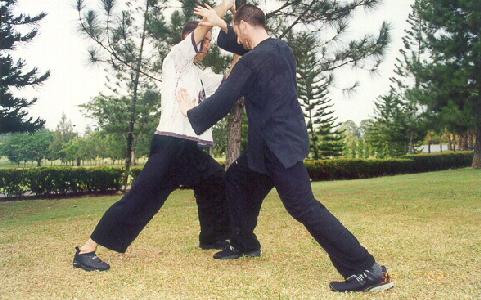
Moving his body forward and shifting his back left leg diagonally forward so that he places himself at Roberto's side, Jeffrey lifts up Roberto's both hands, using the technique of “one hand covering two hands” and simultaneously strikes Roberto's right ribs with his left palm, employing the pattern “Jade Girl Threads Shuttle”. Jeffrey employs good bodywork and footwork, and uses the tactic of “defence cum counter”.
Question 2
Being very skinny and weak, I am very concerned about losing even more muscular strength as time passes. I have had negative results from a Western approach (perhaps I have an innate deficiency of sorts?) but worry that if I stick only to “Lifting the Sky” then I will suffer overall weakness.
Answer
What you said is correct from the conventional Western perspective. But from the chi kung perspective, it is incorrect. My own master, Sifu Ho Fatt Nam, was small-sized, but he was tremendously powerful.
“Lifting the Sky” is a wonderful exercise. Even if you had an innate deficiency of some sorts, it can overcome the deficiency problem, besides giving you some healthy weight and force. Remember that it is not a physical exercise that only works on your muscles and bones, but an energy exercise that harmonizes your energy network. In simple Western terms, this means it restores all your bodily functions, including overcoming deficiency problems.
A physical exercise will deplete your energy. But an energy exercise is different, it increases your energy. In other words, when you perform any physical exercise, you have less energy after the exercise, but when you practice a genuine chi kung exercise, you have more energy at the end of the exercise than at the beginning. Hence, if you practice “Lifting the Sky” consistently, you will have more strength.
It is best if you can attend my Intensive Chi Kung Course in Malaysia. The next one is in March. Please see my website for details. The next best thing is to attend my regional chi kung classes. I shall conduct some in Toronto in April.
But if for any reasons you cannot attend my Intensive Chi Kung Course or my regional chi kung classes, you can learn from my books. For the time being, just practice “Lifting the Sky” everyday. Don't worry about the other exercises. You derived good benefits in the past practicing “Lifting the Sky” on your own. You will get better result doing it again.
Question 3
I believe you yourself wrote that one would benefit more from calisthenics than chi kung if the latter were performed incorrectly (as it is easy to do without the presence of amaster).
Answer
This is true, especially if it is advanced chi kung like zhan zhuang which is simple but not easy. “Lifting the Sky” is comparatively easy, and it is relatively safe even if you may make some mistakes unwittingly. Remember to be relaxed, and do not use brutal strength.
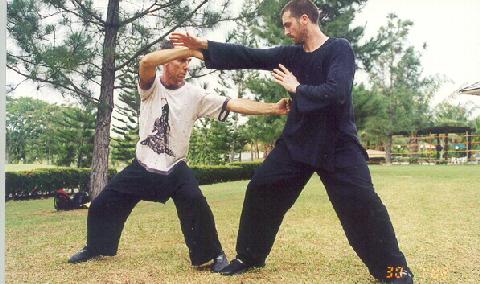
By a skilful shift of his back right leg diagonally backward, and changing from a left Bow-Arrow Stance to a sideway Horse-Riding Stance, Roberto avoids Jeffrey's attack and counter-attacks at the same time with the pattern “Striking Tiger”. Here, Roberto use the tactic of “no defence direct counter”, striking Jeffrey almost at the same time when Jeffrey's attack is spent.
Question 4
Previously I had also performed zhan zhuang consistently for six months incorrectly and had gotten weaker overall, despite my improved standing ability! Scientific studies have shown that individuals lose bone density unless strength training is performed. Even fit, muscular swimmers suffer this loss due to the absence of resistance in their training.
This concerns me as I do not want to lose any further strength and bone density! Surely if I do not directly work my muscles then they will atrophy considerably? I do not doubt the power of chi kung exercise, rather I have definite doubts about my ability to perform it correctly!
Answer
You became weaker from your incorrect zhan zhuang training because it caused blockage that disrupted energy flow. It was the same in principles when you performed Western calisthenics in the past.
Both performing zhan zhuang wrongly and performing Western calisthenics correctly (according to Western concepts) involve muscular tension, and muscular tension causes energy blockage. When you do not have sufficient energy to work your systems because the energy has been blocked, you will naturally become weak.
The concepts that individuals lose bone density if they lack strength training, and that if they do not work their muscles, their muscles will atrophy, are Western ones and may not be universally correct. Kungfu masters, for example, do not perform strength training or work their muscles the way Westerners do, yet these masters are healthy and powerful even at advanced age. On the other hands, some top Western athletes (including top Boxers) perform strength training and work their muscles, yet, sadly, some of them suffer from astrophy!
Two years ago I had a marvelous success with a student who did not have enough bone density to support her body weight. When she met me, she could not stand up. Her specialist doctors recommended bone grafting which would necessitate her being on a wheel chair and clutches for three years. Yet, by practicing the chi kung exercises she had learned from me in a Personalized Chi Kung Course, she recovered completely in a few months! Her success is one of my proudest and happiest achievements.
What you need to clear is not just energy blockage but mental blockage. You need to have faith in yourself, besides having faith in chi kung. There is quite a wide margin of allowance for mistakes in chi kung. Unless the type of chi kung your practice is advanced, or the mistakes are severe and you stubbornly continue to make them despite warning signals, making a few mistakes unintentionally or carelessly not only does not bring serious harm, it may still bring your benefits from your practice. So don't worry about mistakes you may or may not make, but get on to your practice and enjoy yourself.
Question 5
I find that you are far more forthcoming about the potential for mistakes in chi kung practice than other teachers, who seem to make chi kung exercises seem foolproof when they are obviously not.
Answer
My warning about harmful side-effects due to incorrect chi kung training is earnestly meant for those who mess about in chi kung, often ignoring the masters' advice and sometimes trying to improve upon the methods recommended by the masters when they themselves have not even learnt the art sufficiently. Such persons have little respect for the masters nor the art. They imagine they could become experts in advanced chi kung in a matter of weeks and then teach others, when the masters have taken years to practice.
You certainly do not belong to this category. You are aware that practicing chi kung needs time and patience, seek advice respectfully, and try your best to follow instructions. But you must not fall into the other extreme of over-worrying and becoming too nervous to practice. Remember that so long as you follow the instructions respectfully, practicing chi kung is safer than walking down a street.
Even if you make mistakes, it does not necessarily follow that you will have harmful effects. As mentioned above, many mistakes are allowable.
Even if you have side effects, not all are serious. Some side effects are marginal in harm, and can be naturally overcome by the chi kung exercise itself, often without your conscious knowing.
Normally serious harmful effects do not happen suddenly. It takes time for chi kung effects, both beneficial and harmful, to develop. There will be sufficient warning signs for harmful effects. If you heal the warning, the harmful effects can be avoided.
Even if you have developed serious harmful effects, that is not the end of the world. The serious harmful effects can be rectified. There are many chi kung masters and Chinese physicians whom you can turn for help. If you need my help, please feel free to contact me. Although I charge very high fees for my courses, when someone is in need of help due to serious harmful effect, I usually render help freely.
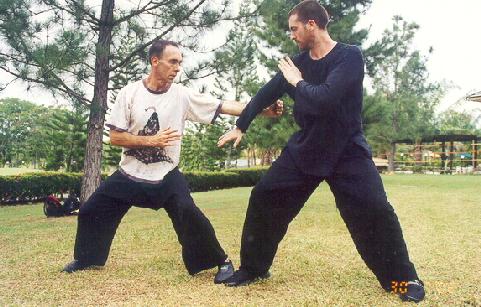
Jeffrey shifts his body slight backward (not shown in the picture) and brushes away Roberto's attack with a “Cloud Hand”. Jeffrey is about to counter-attack, employing the tactic of “defence-cum-counter”.
Question 6
What would be the best way to learn the art of pi-kong-zhang? Do you know any masters whom I could ask for teaching me?
— Beat, Switzerland
Answer
”Pi Kong Zhang” or the art of striking across empty space, is an advanced martial art. A master with this ability can injure an opponent without physical contact, but by striking a few feet in front of him. Such an art, naturally, is taught only to tested disciples.
Master Paul Dong and lady Master Ou Yang Min are masters of this art, although they call it “Empty Force”. I have not met them personally. You can find out their contact particulars by surfing the internet..
Question 7
A TCM practitioner said that I had internal cold (nei han). The symptoms include being scared of cold and feeling cold easily (which is true in my case). He advised that I should dispel this internal cold before I could seriously advance in Taijiquan. He also advised that I ate heaty food (which I avoid because I get heaty easily and will then break out in cold sores) and also that I perspired often (which I do).
This is something new to me. It never crossed my mind that I had internal cold as I have been healthy for a long time already — thanks to my Taijiquan practice. All along I thought I was scared of cold because I was naturally tall and thin (despite having a big appetite all the time) and had very little body fat (insulation).
May I ask for your advice on what I can do to dispel this internal cold?
— Yang, Singapore
Answer
“Internal cold” is a Chinese medical term meaning that the person's physiological functions are working below par. This is expressed as yin deficiency, which may be caused by too little yin or too much yang. In other words, the cause of your body systems not working at peak performance can be due to your organs (represented by yin) being innately weak, or due to you overworking or over-exercising (represented by yang).
If the cause is due to insufficient yin, which seems to be your case, taking extra nutritious food, such as “heaty food” mentioned by you, would aggravate your problem instead of overcoming it. Your physiological functions are already weak. Adding more nutrients would overburden them.
A better approach is to take food that “nourishes yin” and that “circulates qi and livens blood”. Some examples of food or herbs that “nourishes yin” are dong chong cao (winter-insect-grass), xue jia (snow frog) and yan wo (swallows' nest). Some examples of food or herbs that “circulate qi and liven blood” are dang shen (equivalent ginseng), gan cao (fragrant grass), dang gui (immediate return), and hung zao (red date),
Nevertheless, the best approach is to practice chi kung. Amongst other wonderful benefits, practicing chi kung regularly will first restore all your physiological functions, giving you good health, and then enhance them, giving you vitality.
You have not been sick for a long time because you practice Taijiquan, which is a form of chi kung. However, the chi kung effects of your Taijiquan are just strong enough for the first level of benefits, which is giving you good health, but insufficient to progress to the second level, which is giving you vitality, including keeping you warm.
You may like to know that our Shaolin Wahnam chi kung keeps us warm and spirited even in winter. When I teach in Europe in winter, for example, new students are covered with layers of clotings, but I wear just one piece of my kungfu dress. To us in Shaolin Wahnam, everyday is a beautiful day, irrespective of whether the sky is sunny or over-cast.
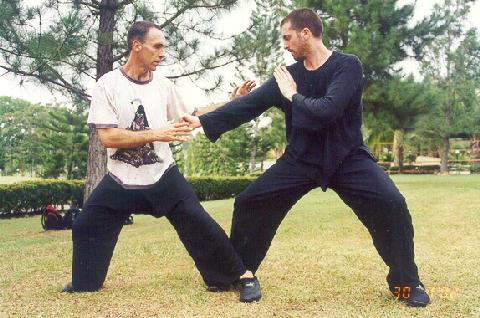
Immediately after brushing away Roberto's attacking hand (shown in the previous picture), Jeffrey lowers into a sideway Horse-Riding Stance and simultaneously strikes Roberto with a low punch. Roberto sinks his body slightly backward to avoid the punch and is about to grip Jeffrey's attacking arm.
Question 8
Could you please give a brief weekly timetable of a Taijiquan workout. I don't know how much time I should spend between forms and stance training and weapons.
— Ryan, South Africa
Answer
Depending on various factors like aims and objectives, developmental stages, available time and resources, as well as individual whims and fancies, different workouts suit different people.
The following are three different weekly workouts for three different categories of students. Of course they are only suggestions and general guidelines. Interested students may make their own modifications.
The first category is for those who want to practice Taijiquan, or Taiji dance, for fun. They may or may not know that Taijiquan is a serious internal martial art demanding much effort, but they are generally not prepared to put in that kind of effort.
Their practice is mainly performing forms. If they know only one Taiji set, they would have to practice this set everyday. If they know a few sets, including weapon sets, they can practice a different set a day by roatation. They should perform the forms of the set without worrying about breathing, and without using mechanical strength. They should, however, pay some attention to good balance and graceful movements. They would get more benefits if they could just stand still and be relaxed for a few minutes before and after their set performance.
The second outwork is for those who know and wish to practice Taijiquan as an internal martial art, but are not ready to put in a lot of hard work.
Their practice can be divided into three aspects, namely forms, force training and combat application. They should spend about 50% of their training time on forms, and 25% each on force training and combat application. For form training, they follow the same format of the first group, except that they spend only about 50% of their training time, whereas the first group spend 100%. For force training, they practice the “Three-Circle Stance”, the pattern “Lifting Water” and the pattern “Grasping Sparrow's Tail” for about 5 minutes each. For combat application, they practice “Pushing Hands”, “Striking Hands” and simulated sparring for about 5 minutes each.
The third outwork is for dedicated students who wish to practice Taijiquan as an internal martial art. It demands hard work and is no fun, but if the students persist they will have many wonderful benefits and subtle joys.
Their training is mainly on force training and combat application, the two pillars of good martial arts. Without these two aspects, Taijiquan degrades into a dance, and can never be internal and martial. The allocation of training time is about 45% on force training, 45% on combat application, and 10% on set performance. Please note that forms are used to train force or combat application, like performing a set or parts of it to enhance chi flow or breath control, and this is not counted as performing sets.
Force training must be progressive. For example, initially they may practice the “Three-Circle Stance” for a few minutes, but gradually increase to 15 minutes or more. Besides “Three-Circle Stance”, “Lifting Water” and “Grasping sparrow's Tail”, they should also employ appropriate methods to develop fluidity of movements, sensitivity, stamina, explosive force, quick decision making, one-pointed mind and mental clarity. For combat application, besides “Pushing Hands” and “Striking Hands”, they should also practice body movements, footwork, miscellaneous techniques, combat sequences, free sparring, tactics and strategies.
The three workouts are meant for a week. Students should space out the materials sensibly for their day to day practice. They may, for example, practice the “Three-Circle Stance” everyday, but “Lifting Water” and “Grasping Sparrow's Tail” on alternate days. For “Pushing Hands” and “Striking Hands”, however, it is better to focus on one training sequence everyday for some time so as to consolidate the relevant skills developed, before moving on to the next sequence.
LINKS
Selected Reading
- Sparring Without Protective Gear — Anthony Korahais
- Zen, Buddhism and Spiritual Cultivation
- My Chi Kung Experience — Michael Durkin
- Combat Sequence 10 — White Horse Presents Hoof
- Practicing is Something I Look Forward to Everyday — Richard Broadhead
